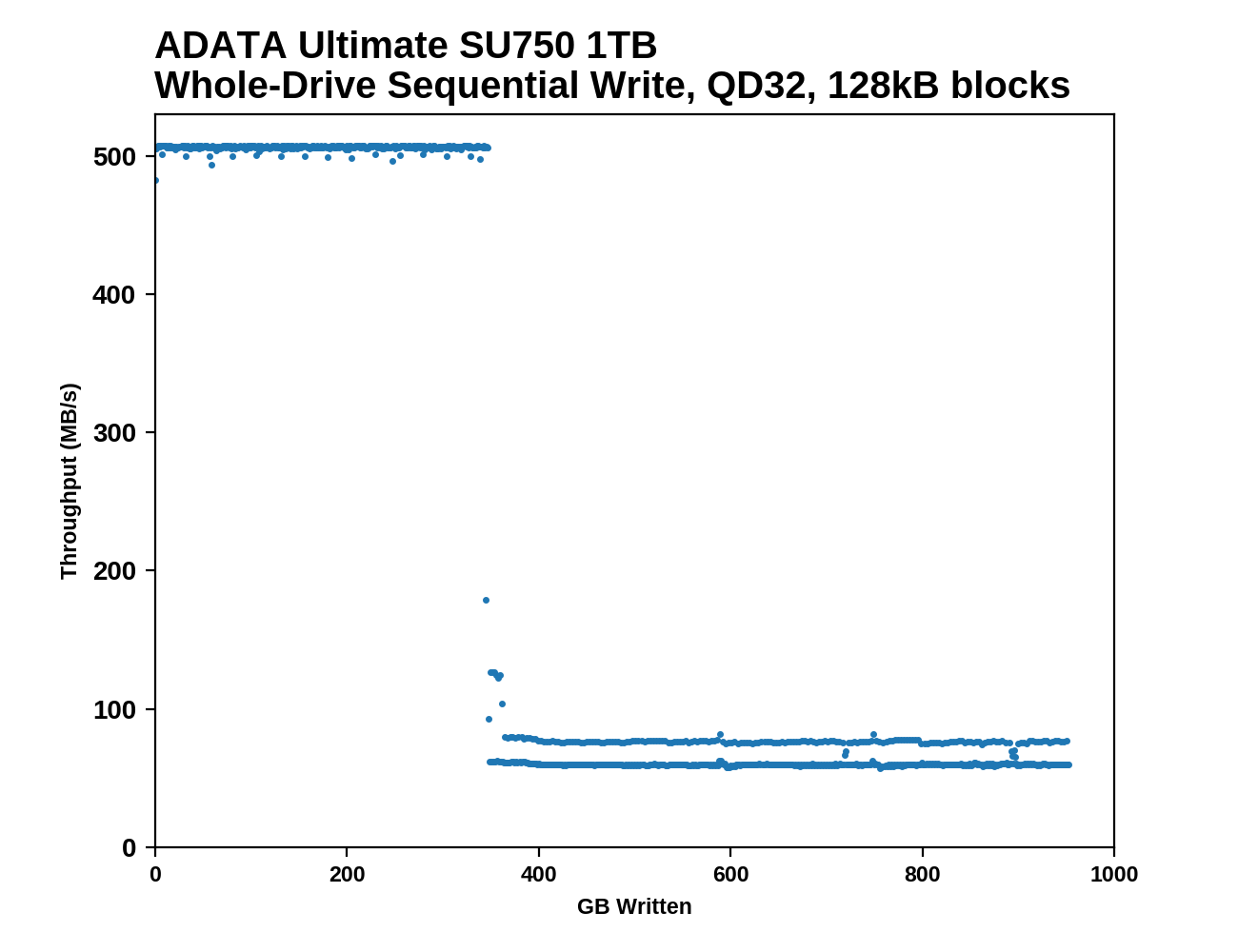The ADATA Ultimate SU750 1TB SSD Review: Realtek Does Storage, Part 1
by Billy Tallis on December 6, 2019 8:00 AM ESTWhole-Drive Fill
This test starts with a freshly-erased drive and fills it with 128kB sequential writes at queue depth 32, recording the write speed for each 1GB segment. This test is not representative of any ordinary client/consumer usage pattern, but it does allow us to observe transitions in the drive's behavior as it fills up. This can allow us to estimate the size of any SLC write cache, and get a sense for how much performance remains on the rare occasions where real-world usage keeps writing data after filling the cache.
 |
|||||||||
The SLC write cache on the 1TB ADATA SU750 is quite large, lasting for about 345GB of sequential writes before performance drops down to QLC-like speeds. In both phases, the performance is very consistent, and the transition when the SLC cache fills up is abrupt.
 |
|||||||||
| Average Throughput for last 16 GB | Overall Average Throughput | ||||||||
The post-cache write speed of the SU750 is actually even slower than the QLC-based Samsung 860 QVO, but the much larger cache on the SU750 means its overall average write speed across the entire drive filling process is slightly faster.
Working Set Size
When DRAMless SSDs are under consideration, it can be instructive to look at how performance is affected by working set size: how large a portion of the drive is being touched by the test. Drives with full-sized DRAM caches are typically able to maintain about the same random read performance whether reading from a narrow slice of the drive or reading from the whole thing. DRAMless SSDs often show a clear dropoff when the working set size grows too large for the mapping information to be kept in the controller's small on-chip buffers.
 |
|||||||||
The QD1 random read performance of the SU750 is fairly low regardless of the working set size. There's no clear indication of performance being affected by the size of the controller's caches for mapping information. Even when the random reads are confined to a mere 1GB slice of the drive, performance is no better than when reading from the entire drive. The Intel 660p is the only drive in this bunch that does show a clear performance drop, caused by it having a 256MB DRAM cache instead of the more typical 1GB for a 1TB drive.










54 Comments
View All Comments
romrunning - Friday, December 6, 2019 - link
This whole suite of tests reminds me of how terrible QLC is for performance, whether in the woeful Intel 660p or this ADATA SU750. YMMV, but I'm okay with never buying one.Also, I can remember back in the days when I first saw Realtek pop up in networking. There were usually issues, and then you had to replace them with a 3Com NIC. But "cheap" is king, and guess who is still around. Now you know what your parents felt like when they reminisce about the "good old days".
extide - Friday, December 6, 2019 - link
This drive does not use QLC.romrunning - Friday, December 6, 2019 - link
Sorry - true, it doesn't use QLC; the SU750 is just DRAM-less.PeachNCream - Friday, December 6, 2019 - link
ADATA can make SSD performance suck even without QLC and price it as if it is a competitive product. That's sort of an accomplishment in its own way.brucethemoose - Friday, December 6, 2019 - link
I wonder how low they could go with QLC instead of TLC. Maybe the extra work required to get QLC even functioning on this Realtek controller would negate any savings.name99 - Friday, December 6, 2019 - link
Remember not everyone NEEDS every aspect of performance!I would prefer to have my audio-visual library on SSD so that searching is faster (waiting a few seconds for drive spin-up is always irritating) but no aspect of QLC (eg reduced total write volume, or slow writes) is problematic for that use case...
PeachNCream - Friday, December 6, 2019 - link
Agreed, but if the SSD in question is slower than a different SSD with similar endurance and capacity that is priced the same, why get less for your money just because your p0rn collection doesn't need low latency responsiveness?Samus - Saturday, December 7, 2019 - link
The thing is, the 660p and now 665p are great drives for average users. You get rock bottom price (though the drives mysteriously spiked up by 30% recently) and a decently reliable drive that delivers good burst transfer rates. Write performance is fine, still faster than a SATA drive until the pSLC is cached.rrinker - Friday, December 6, 2019 - link
Would really like to see some "low end" 2 or eve 4TB SSDs. Even a low end SSD is faster than a spinny disk, and I'd love to build my whole server with SSD - a pair of higher end ones for a fast cache, with a bunch of low end ones for the mass storage.FunBunny2 - Friday, December 6, 2019 - link
"Even a low end SSD is faster than a spinny disk"true, but HDD that get past infant suicide can last a very long time.